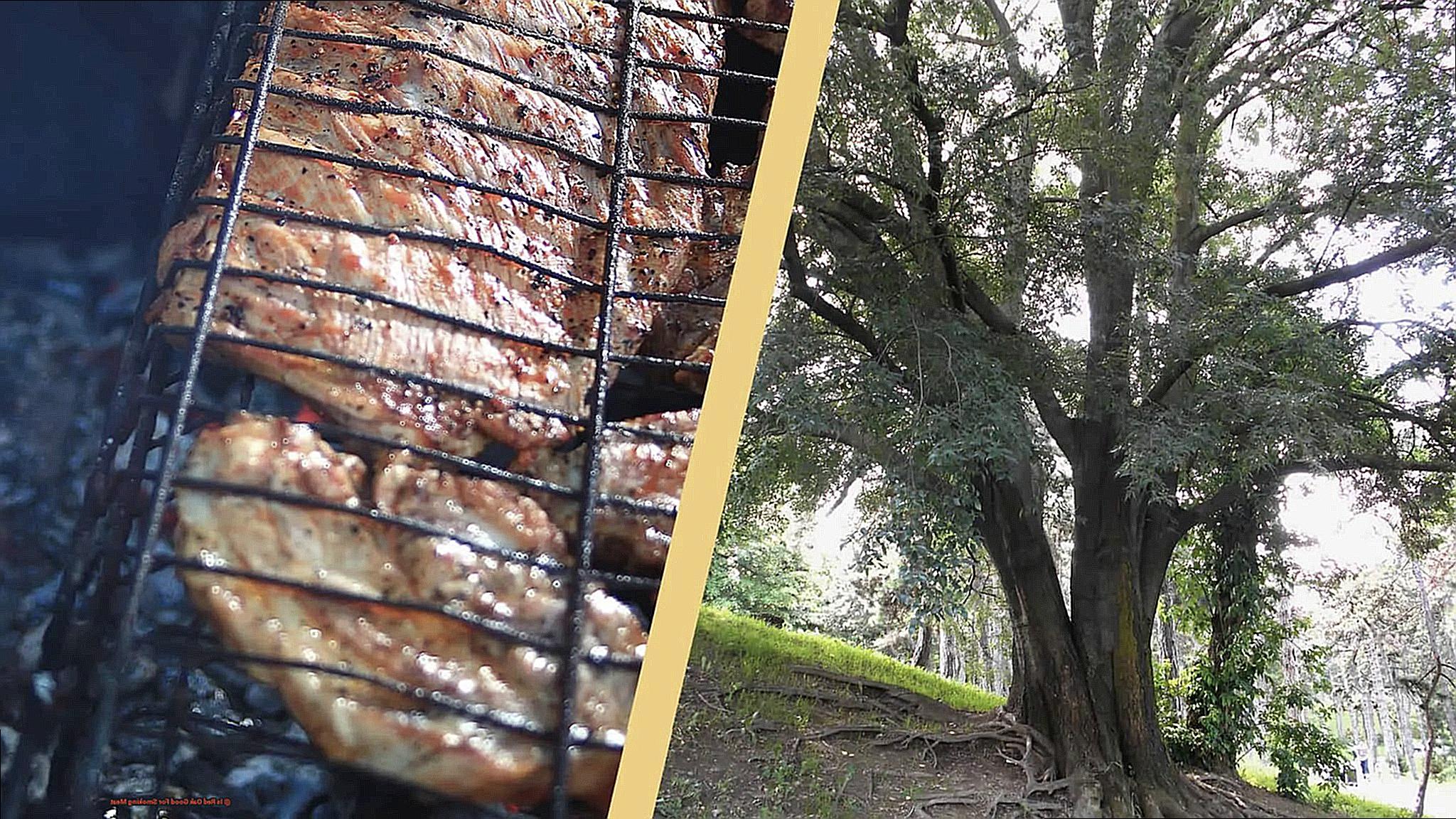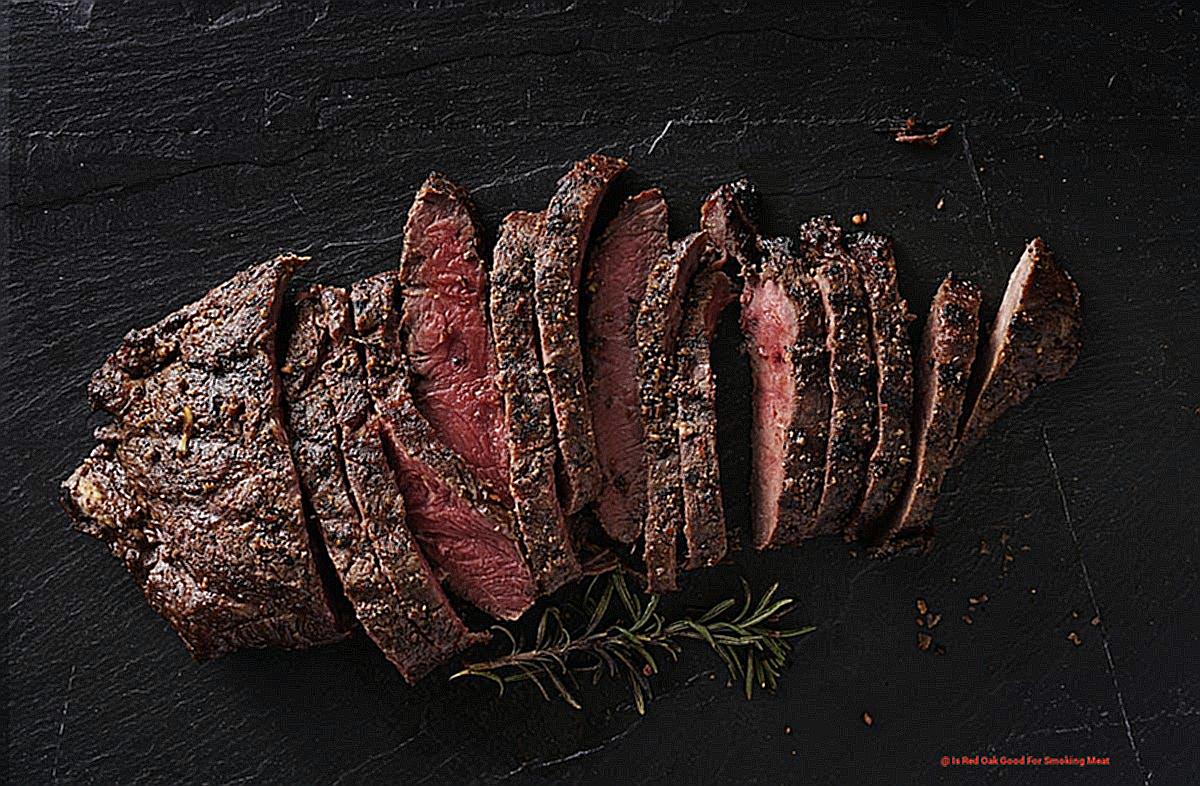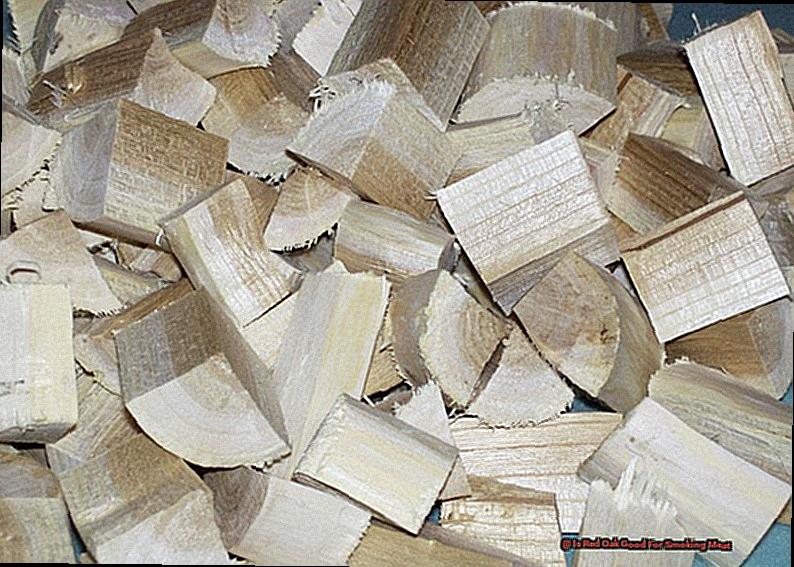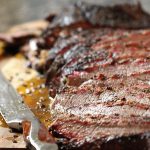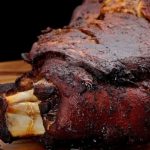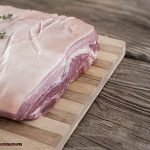Are you tired of the same old flavors when it comes to smoking your meats? Look no further, because we have the perfect solution for you – red oak. This versatile wood has been a staple in smoking and grilling for centuries, and for good reason.
Not only does it impart a unique and mouth-watering flavor to your meats, but it also offers numerous benefits that set it apart from other types of wood.
Don’t just take our word for it – here’s why red oak is the ultimate game-changer when it comes to smoking meat:
- Bold and robust flavor: Red oak infuses your meats with a bold, smoky flavor that is unrivaled by any other wood.
- Versatility at its finest: From beef to pork, poultry to seafood, red oak can be used with a variety of meats.
- Slow and steady burn: Unlike other woods, red oak burns slowly and steadily, allowing for longer cooking times without constantly adding more wood.
- Low moisture content: With its low moisture content, red oak produces less smoke and prevents your meats from becoming overly smoky or bitter.
- Easy accessibility: While some specialty woods may be hard to come by, red oak can be easily found at most hardware stores or online.
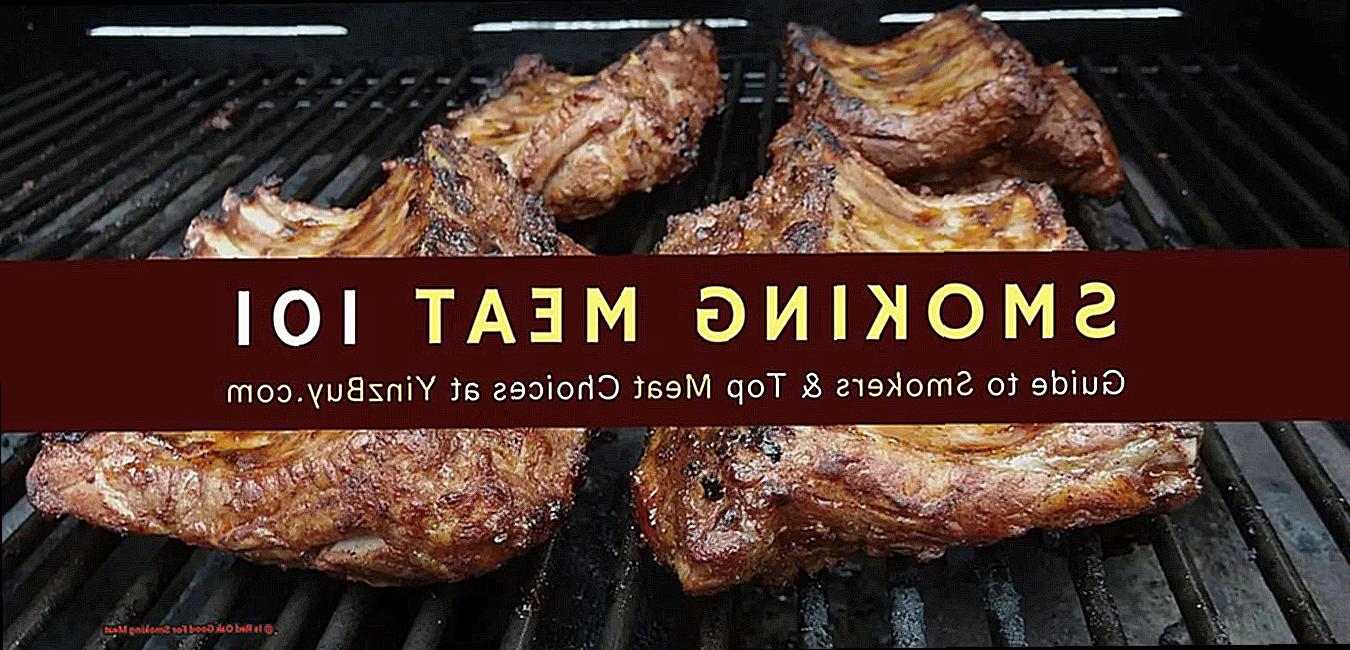
So, why settle for mediocre when you can elevate your BBQ game with the help of red oak? Keep reading to discover more about its benefits and how to effectively use it in your next smoking session.
Contents
Oak Smoking
When it comes to smoking meat, using red oak offers a distinctive and versatile flavor profile that sets it apart from other types of wood. While some may find it too strong for certain meats, it is a top choice among BBQ enthusiasts for its exceptional pairing with beef and pork. Let’s take a closer look at how red oak stands out compared to other commonly used smoking woods.
| Wood | Flavor Profile | Best Meat Pairings |
|---|---|---|
| Red Oak | Mild, sweet, and smoky | Beef and pork |
| White Oak | Mild and slightly sweet | Fish and delicate meats |
| Post Oak | Mild and smoky | Brisket |
| Hickory | Strong and bacon-like | Pork and poultry |
| Fruit woods (apple, cherry, peach) | Sweet and fruity | Poultry, pork, and vegetables |
| Mesquite | Strong and earthy | Beef, game meats, and vegetables |
| Alder | Mild and slightly sweet with a hint of smoke | Fish and poultry |
The flavor profile of red oak falls in the middle of the spectrum, making it a versatile wood for smoking various meats. It is not as overpowering as hickory or mesquite, but it offers more complexity than fruit woods or alder.
In terms of usability, red oak is relatively easy to find and work with. It is a hardwood that burns evenly and slowly, making it ideal for longer smoking sessions. However, it is essential to use high-quality, well-seasoned red oak to avoid any unpleasant or bitter flavors.
Compared to other types of wood, red oak is also more versatile in terms of the meats it can be used to smoke. From beef and pork to poultry and vegetables, red oak adds a delicious smoky flavor to all types of meats. It is also perfect for smoking turkey as it helps keep the meat tender while adding a subtle sweetness.
What Is Red Oak?
This hardwood burns evenly, producing a gentle and sweet smokiness that complements a variety of meats. Its moisture retention properties also play a key role in keeping the meat juicy and adding a crispy texture to the skin. Red oak is particularly well-suited for smoking beef, pork, and poultry but can also be used for other meats like fish, lamb, game meats, and vegetables.
The table below outlines the main reasons why red oak is the preferred wood for smoking meat.
| Reason | Description |
| Availability | Red oak is widely accessible in different regions of the United States, making it a convenient option for BBQ enthusiasts. |
| Affordability | Compared to other hardwoods such as cherry or hickory, red oak is relatively budget-friendly, making it an economical choice for smoking meat. |
| Flavor Profile | Red oak offers a gentle and sweet smokiness that complements various meats without overpowering their natural flavors. |
| Burn Quality | Red oak burns evenly and consistently, making it perfect for extended smoking sessions and maintaining a consistent temperature throughout. |
| Versatility | Aside from beef and pork, red oak can also be used to smoke other meats such as fish, lamb, game meats, and vegetables. |
| Moisture Retention | The high moisture content of red oak helps keep the meat juicy during the smoking process, preventing it from drying out. |
So, the unique combination of widespread availability, affordability, flavor profile, and burn quality makes red oak a top choice for smoking meat among BBQ enthusiasts. Its versatility and ability to retain moisture are additional reasons why it is the preferred wood for smoking various types of meat. However, it is important to note that the quality of red oak can vary depending on factors like age and location.
Why Is Red Oak Good For Smoking?
Red oak enhances the flavor of smoked meat in a multitude of ways.
- Delicate, smoky taste: Red oak delivers a subtle, yet noticeable smokiness that does not overpower the natural flavors of the meat. This makes it a favored option among pitmasters who desire a gentle hint of smokiness in their meat.
- Complements an array of meats: Red oak pairs perfectly with various meats such as beef, pork, and poultry. Its medium-to-strong smoke profile adds a bold and complementary flavor to these meats, enhancing their taste and making them more delectable.
- Versatile application: The use of red oak is not limited to only smoking beef, pork, and poultry. It can also be utilized for smoking fish, lamb, game meats, and vegetables, making it an adaptable option for all types of BBQ dishes.
- Retains moisture: Unlike other woods that can dry out the meat when smoked for extended periods, red oak has the unique ability to retain moisture. This ensures that the meat remains juicy and tender while still achieving the desired smoky flavor.
- Ideal for smoking turkey: When it comes to smoking turkey, red oak is an exceptional choice as it adds flavor without drying out the meat. It also aids in achieving that perfect golden-brown color on the skin that is highly sought after in smoked turkey.
In conclusion, red oak is an excellent option for smoking due to its delicate yet distinct smokiness, versatility in pairing with various meats, ability to retain moisture, and outstanding results when used to smoke turkey.
Characteristics Of Red Oak For Smoking
When it comes to smoking meat, red oak is a top choice for many BBQ aficionados. Its popularity is due to several key characteristics that make it an ideal option for enhancing the taste of meat.
Flavor Profile:
Red oak boasts a mild, sweet, and nutty flavor that adds depth and complexity to meat without being overpowering. This makes it perfect for smoking a variety of meats with varying flavors.
Slow and Even Burn:
Being a hardwood, red oak burns at a steady pace, providing consistent heat over an extended period of time. This makes it ideal for slow cooking and smoking meats to perfection.
Different Types:
Not only does red oak have a unique flavor, but there are also different types available, each with its own distinct taste profile. For instance, Texas Red Oak has a stronger smoky flavor, while Southern Red Oak has a more subtle taste. Another type of oak used for smoking, Live Oak, offers a slightly sweeter and nuttier flavor compared to red oak.
Availability:
One of the significant advantages of using red oak for smoking is its availability in many parts of the US. This makes it easily accessible for BBQ enthusiasts looking to use this wood for their next cookout.
Versatility:
Red oak is incredibly versatile and can be used to smoke various types of meat, including beef, pork, poultry, and fish. Its adaptability makes it a popular choice among BBQ enthusiasts who enjoy experimenting with different flavors.
In addition to these key characteristics, it’s crucial to properly season the wood before using it for smoking. This ensures that the wood burns clean and does not release any unwanted flavors or toxins into the meat.
Overall, red oak is an excellent option for adding delicious smoky flavors to your BBQ. Its unique traits make it a versatile and sought-after choice among BBQ lovers, and its widespread availability in the US makes it easily accessible to all.
Pros And Cons Of Red Oak For Smoking
Red Oak is a popular choice for smoking meat due to its numerous advantages, but it also has some drawbacks that should be taken into consideration.
Pros:
- Subtle and Savory Flavor: Red oak infuses a gentle and nutty flavor that enriches the natural taste of the meat without being overpowering. It imparts a delicate smoky taste that pairs perfectly with beef and pork.
- Slow and Consistent Burn: As a hardwood, red oak burns slowly and evenly, making it ideal for extended smoking sessions. This ensures that the meat is cooked uniformly and does not dry out.
- Versatility: Red oak can be used to smoke various types of meat, such as beef, pork, poultry, and game meats. Its flavor profile complements these meats well, providing a unique taste experience.
- Accessibility: Red oak is widely available across the US, making it easily accessible to those who want to use it for smoking meat.
Cons:
- Intense Flavor: While many enjoy the nutty flavor of red oak, some may find it too robust for their palate. It is advisable to use red oak sparingly and mix it with milder woods to balance out the taste.
- Potential for Bitter Smoke: If not properly seasoned or used in large quantities, red oak can produce bitter smoke that may negatively impact the flavor of the meat.
- Not Suitable for All Meats: While red oak pairs well with beef and pork, it may not be suitable for other types of meat like fish or delicate cuts.
In summary, red oak has numerous benefits as a smoking wood but also has potential downsides that should be kept in mind. It is essential to use it in moderation and mix it with other woods for a well-rounded flavor profile.
Types Of Red Oak
There exist three primary varieties of red oak utilized for smoking meat: red oak, white oak, and post oak. Each type possesses distinct characteristics that influence the flavor of smoked meat in unique ways.
Red Oak
- Intense and smoky taste
- More robust than other types of wood
- Complements beef, pork, and poultry well
- Can be balanced by using milder meats or adjusting wood quantity
White Oak
- Less intense than red oak
- Better suited for delicate meats like fish
- Yields a subtler smoky flavor
Post Oak
- Similar flavor profile to red oak
- Burns at a slower rate and produces less smoke
– Ideal for longer smoking processes, such as brisket
When utilized in smoking meat, red oak can contribute a bold and smoky flavor to the meat. It pairs well with beef, pork, and poultry, but may be too harsh for those who prefer milder flavors.
White oak, on the other hand, is a gentler alternative that is better suited for delicate meats like fish. Post oak has a similar flavor profile to red oak but burns at a slower rate and produces less smoke, making it suitable for longer smoking processes.
To ensure the best results, it is crucial to select high-quality and well-seasoned red oak for smoking meat. Low-quality or old red oak can result in an unsavory taste.
Is Red Oak Toxic For Smoking Meat?
Many people often wonder about the potential toxicity of this hardwood. However, rest assured that red oak is not harmful when used for smoking meat. In fact, it is a popular choice among BBQ enthusiasts due to its even and slow burning qualities, providing a mild and sweet smoky flavor to meats.
But like any strong wood, red oak should be used in moderation and mixed with milder woods for optimal results. Let’s take a look at some popular wood types used for smoking and their respective flavor profiles and meat pairings.
| Wood Type | Flavor Profile | Meat Pairing |
| Red Oak | Bold and smoky | Beef, pork, poultry |
| White Oak | Gentle | Fish, delicate meats |
| Post Oak | Similar to red oak but slower burn and less smoke production | All types of meat |
As you can see, red oak is a bold and smoky wood that pairs well with beef, pork, and poultry. But what about its safety? It is important to note that any type of wood used for smoking should be free of chemicals or additives.
This means using natural, untreated wood specifically sold for smoking purposes. Avoid using wood from construction sites or painted/stained wood as they may contain harmful chemicals that can seep into the meat.
Furthermore, it is recommended to soak red oak wood chips or chunks in water for at least 30 minutes before using them for smoking. This helps to prevent the wood from burning too quickly and producing harsh smoke.
Rest assured that red oak is not toxic for smoking meat. It offers a delicious and unique flavor to various types of meats and can be safely consumed when used correctly. Just remember to always use natural, untreated wood and soak the wood before smoking for best results.
Red Oak Vs White Oak: Which Is Better For Smoking?
When it comes to smoking meat, red oak and white oak are both excellent choices. However, there are some noteworthy distinctions between the two that can affect the taste of your BBQ. Let’s delve into these differences and determine which type of oak is more suitable for achieving the desired flavor.
- Hardness and heat: White oak is known for its superior hardness and density compared to red oak, resulting in a hotter and longer burn. This makes it an ideal choice for larger cuts of meat that require extended cooking time. On the other hand, red oak is softer and burns at a lower temperature, making it more suitable for smaller cuts of meat that require less cooking time.
- Smoke production: Another notable difference is the amount of smoke produced by each type of oak. White oak produces more smoke, which can be beneficial for imparting a strong smoky flavor to your meat. However, too much smoke can overpower the natural flavors of the meat, so it’s important to use white oak in moderation.
- Flavor profile: The distinctive flavor profiles of red oak and white oak also differ. Red oak has a bolder and more pronounced taste with hints of nuttiness and slight sweetness. In contrast, white oak offers a milder flavor with subtle woody notes.
Based on these variations, it can be concluded that both types of oak have their own merits when it comes to smoking meat. Ultimately, the choice between red oak and white oak depends on personal preference and the type of meat being smoked. For those looking for a stronger and more intense flavor, red oak would be the better option. On the other hand, if you prefer a more delicate smoky taste, then white oak would be a suitable choice.
| Criteria | Red Oak | White Oak |
| Hardness and Heat | Medium hardness and density | Superior hardness and density |
| Smoke Production | Produces less smoke | Produces more smoke |
| Flavor Profile | Bolder, pronounced, hints of nuttiness and slight sweetness | Milder, subtle, woody notes |
To sum it up, both red oak and white oak offer unique qualities that make them great choices for smoking meat. It ultimately comes down to personal preference and the type of meat being cooked.
Meat Smoking With Red Oak
Compared to other types of wood, red oak is a great option for smoking meat for several reasons.
- Hardwood Quality: As a hardwood, red oak burns evenly and provides a consistent heat source while smoking, making it easier to control the temperature and maintain a steady smoke. This results in perfectly cooked, flavorful meat.
- Mild Smoky Flavor: Red oak produces a mild, smoky flavor that pairs well with different types of meat. This allows the natural taste of the meat to shine through, while still adding a subtle smokiness that enhances the overall flavor.
- Availability and Affordability: Red oak is widely available and relatively affordable compared to other types of wood used for smoking. This makes it a convenient and cost-effective option for regular barbecuers.
- Versatility: Red oak is versatile and can be used to smoke various types of meat such as beef, pork, poultry, fish, lamb, game meats, and even vegetables. This makes it a great all-around wood for those who like to experiment with different types of smoked food.
- Complements Beef, Pork, and Poultry: Red oak is particularly great for smoking beef, pork, and poultry. It adds a rich and smoky flavor that complements the natural taste of these meats, making them even more delicious.
- Bold Flavor: Red oak may be harsher in taste compared to other woods like fruitwoods or white oak, but many barbecue enthusiasts prefer its bold flavor. This makes it an excellent choice for those who enjoy a stronger smoke flavor in their meats.
So, red oak is an ideal option for smoking meat due to its hardwood quality, mild smoky flavor, versatility, availability, affordability, and bold flavor profile.
Conclusion
In conclusion, red oak reigns supreme in the world of smoking meat. Its bold and robust flavor, versatility, slow burn, low moisture content, and easy accessibility make it a top choice among BBQ enthusiasts.
Unlike other woods, red oak adds a unique and mouth-watering taste to your meats while still allowing their natural flavors to shine through. Its ability to complement a variety of meats and its slow burn also means longer cooking times without constantly adding more wood.
While some may find its flavor overpowering, with proper seasoning and moderation, red oak adds a subtle yet distinct smokiness that enhances the taste of beef, pork, poultry, and even vegetables.
Don’t settle for average when you can elevate your BBQ game with the help of red oak. Give it a try in your next smoking session and savor the difference for yourself.
To truly stand out in the world of smoked meats, one must turn to the power of red oak. This versatile wood boasts a bold and robust flavor that sets it apart from others. Its slow burn allows for extended cooking times without constantly adding more wood chips or chunks.
And with its low moisture content and widespread availability, it’s no wonder why red oak is the go-to choice for BBQ enthusiasts everywhere.

